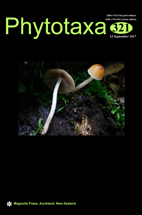Abstract
In order to contribute to the taxonomic revision of several species of Termitomyces, sequences of 74 strains representing 28 taxa were used to generate a combined nLSU-mtSSU phylogenetic tree. The phylogenetic analysis showed that re-classification was required for 12 taxa originally misidentified under various names. The changes led to the use of 8 valid names for these 12 taxa, including two new forms: T. striatus f. subclypeatus and T. medius f. ochraceus; and a new combination: Termitomyces brunneopileatus according to their placement on various clades and subclades in the phylogenetic trees. Termitomyces letestui and T. medius were taxonomically revised. In addition, T. letestui collected from China is the first record from the Asian continent. This species was so far collected only in tropical Africa. Similarly, T. robustus is reported for the first time from Cameroon. Moreover, the phylogenetic analysis confirms T. subumkowaan as a new species that was originally described only on the basis of morphological features. The combined phylogenetic analysis and morphological features reveal that different strains of the same taxon show sometimes large variations in macro- and micromorphological features, some very likely with links to genetic factors other than genes sequenced here, thereby justifying the new forms erected within these taxa in order to facilitate their identification.

